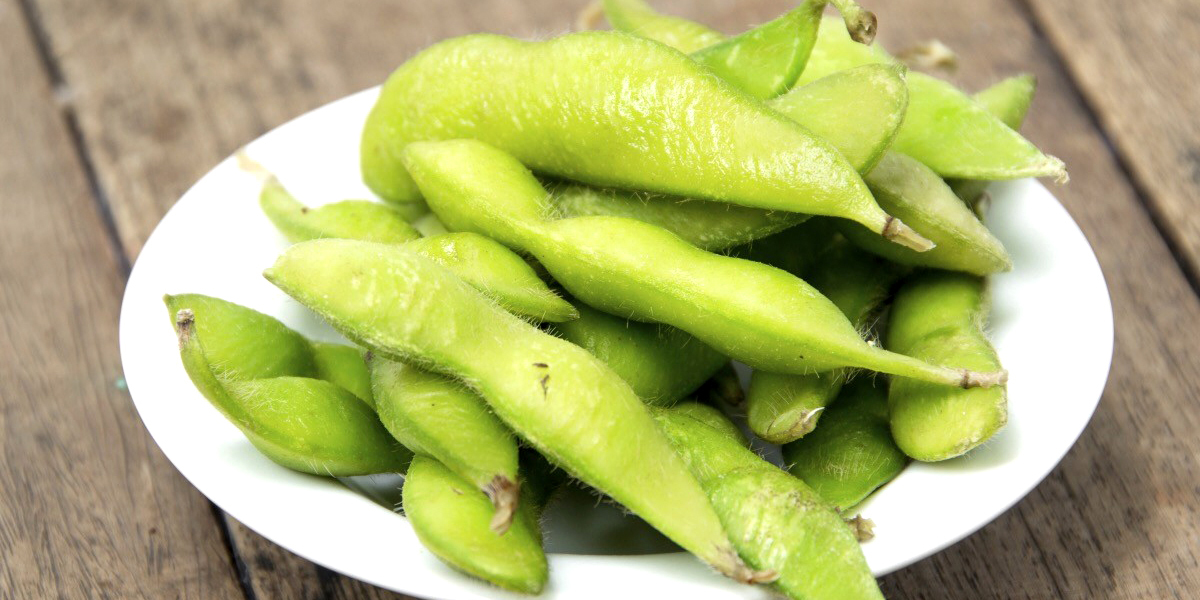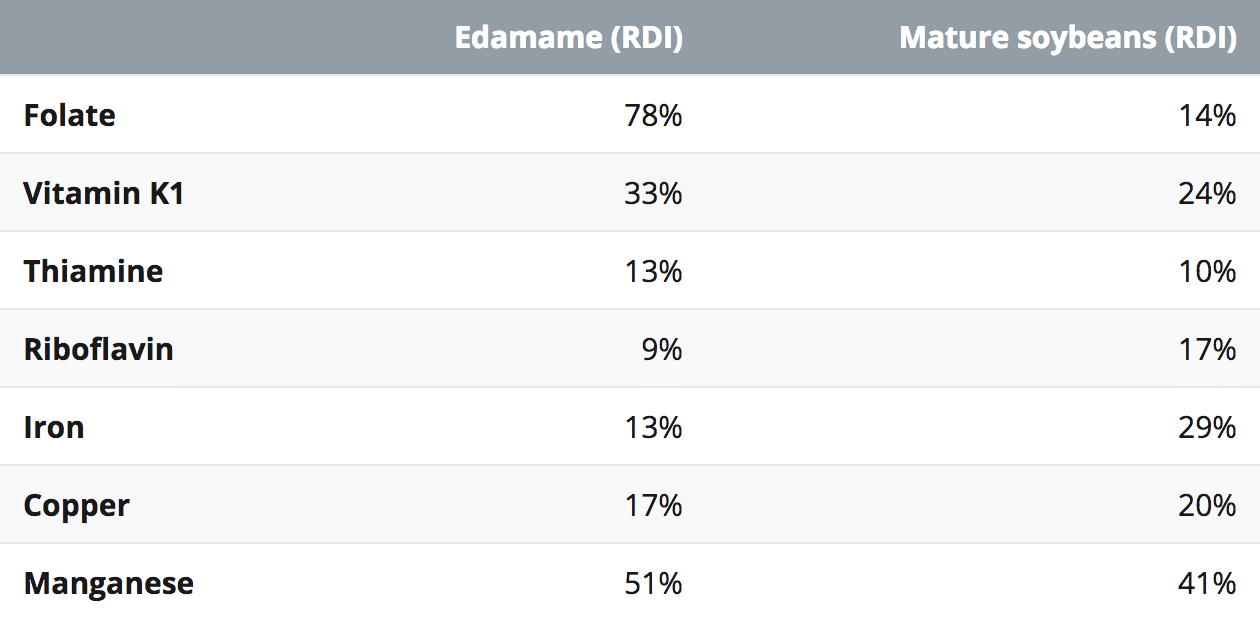

iStock
By Dr. Atli Arnarson
Soybeans are one of the world’s most popular and versatile food crops.
They are processed into a variety of food products, such as soy protein, tofu, soybean oil, soy sauce, miso, natto and tempeh.
Soybeans are also eaten whole, including as immature soybeans known as edamame. Traditionally eaten in Asia, edamame is gaining popularity in Western countries, where it is typically eaten as a snack.
This article lists the main science-based health benefits of edamame.
What is Edamame?
Edamame beans are whole, immature soybeans, sometimes referred to as vegetable-type soybeans.
They are green and differ in color from regular soybeans, which are typically light brown, tan or beige.
Edamame beans are often sold while still encased in their pods, which are not meant to be eaten. You can also buy shelled edamame, without the pods.
In the U.S., most edamame is sold frozen. Generally, you can easily heat the beans by boiling, steaming, pan-frying or microwaving them for a few minutes.
Traditionally, they are prepared with a pinch of salt and added to soups, stews, salads and noodle dishes or simply eaten as a snack.
Edamame is served in sushi bars and in many Chinese and Japanese restaurants. You can find it in most large supermarkets in the U.S., typically in the frozen vegetable section. Most health food stores also carry it.
But is edamame healthy? The answer may depend on who you ask.
Soy foods are controversial. Some people avoid eating soybeans regularly, partly because they may interfere with thyroid function (1).
For more information about people’s concerns, read this article.
Nevertheless, despite these concerns, edamame and soybeans may also have several health benefits. Below are the top 8.
1. High in Protein
Getting enough protein is crucial for optimal health.
Vegans and those who rarely eat high-protein animal foods need to pay special attention to what they eat on a daily basis.
One concern is the relatively low protein content of many plant foods. However, there are a few exceptions.
For instance, beans are among the best plant-based protein sources. In fact, they are the cornerstone of many vegan and vegetarian diets.
A cup (155 grams) of cooked edamame provides around 18.5 grams of protein (2).
Additionally, soybeans are a whole protein source. Unlike most plant proteins, they provide all the essential amino acids your body needs, although they are not as high-quality as animal protein (3).
Summary: Edamame contains around 12 percent protein, which is a decent amount for a plant food. It is also a quality protein source, providing all the essential amino acids.
2. May Lower Cholesterol
Observational studies have linked abnormally high levels of cholesterol with an increased risk of heart disease (4, 5).
One review concluded that eating 47 grams of soy protein per day can lower total cholesterol levels by 9.3 percent and LDL (the “bad”) cholesterol by 12.9 percent (6).
Another analysis of studies found that 50 grams of soy protein per day reduced LDL cholesterol levels by 3 percent (7).
It is unclear if these small-to-modest changes in cholesterol levels translate into a lower risk of heart disease.
Despite these uncertainties, the US Food and Drug Administration approves health claims for soy protein in the prevention of heart disease (8).
In addition to being a decent source of soy protein, edamame is rich in healthy fiber, antioxidants and vitamin K.
These plant compounds may reduce the risk of heart disease and improve the blood lipid profile, a measure of fats including cholesterol and triglycerides (9, 10).
Summary: Edamame is rich in protein, antioxidants and fiber that may lower circulating cholesterol levels. However, it is unclear whether eating edamame has any effects on the risk of heart disease.
3. Doesn’t Raise Blood Sugar
Those who eat lots of easily digested carbs, such as sugar, on a regular basis are at an increased risk of chronic disease (11, 12).
This is because fast digestion and carb absorption spikes blood sugar levels, a condition known as hyperglycemia.
Like other beans, edamame does not excessively raise blood sugar levels.
It is low in carbs, relative to protein and fat. It also measures very low on the glycemic index, a measure of the extent to which foods raise blood sugar levels (13, 14).
This makes edamame suitable for people with diabetes. It’s also an excellent addition to a low-carb diet.
Summary: Edamame is low in carbs. It is suitable for people with type 2 diabetes, as well as those who follow a low-carb diet.
4. Rich in Vitamins and Minerals
Edamame contains high amounts of several vitamins and minerals, as well as fiber.
The table below shows the levels of some of the main vitamins and minerals in 3.5 ounces (100 grams) of edamame and mature soybeans, comparing the two (2, 15).
Edamame contains significantly more vitamin K and folate than mature soybeans.
In fact, if you eat a whole cup (155 grams), you will get around 52 percent of the RDI for vitamin K and more than 100 percent for folate.
Summary: Edamame is rich in several vitamins and minerals, especially vitamin K and folate.
read page 1
5. May Reduce the Risk of Breast Cancer
Soybeans are high in plant compounds known as isoflavones.
Isoflavones resemble the female sex hormone estrogen and may bind weakly to its receptors, which are located on cells throughout the body.
Since estrogen is thought to promote certain types of cancer, such as breast cancer, some researchers believe consuming large amounts of soybeans and isoflavones may be risky.
Several observational studies have associated a high intake of soy products or isoflavones with increased breast tissue, potentially increasing the risk of breast cancer (16, 17, 18).
Yet, most similar studies suggest that a high intake of soybeans and soy products may slightly reduce the risk of breast cancer (19, 20, 21).
They also indicate that a high intake of isoflavone-rich foods early in life may protect against breast cancer later in life (22, 23, 24).
Other researchers found no protective effects of soy on the risk of breast cancer (25).
However, long-term controlled studies are needed before any solid conclusions can be reached.
Summary: Observational studies suggest that soy-based foods like edamame may reduce the risk of breast cancer, but not all studies agree.
6. May Reduce Menopausal Symptoms
Menopause is the stage in a woman’s life when she stops menstruating.
This natural condition is often associated with adverse symptoms, such as hot flashes, mood swings and sweating.
Studies indicate that soybeans and isoflavones may slightly reduce adverse symptoms during menopause (26, 27, 28, 29).
However, not all women are affected by isoflavones and soy products in this way. In order to experience these benefits, women need to have the right types of gut bacteria (30).
Certain types of bacteria are able to convert isoflavones into equol, a compound believed to be responsible for many of the health benefits of soybeans. People with these specific kinds of gut bacteria are called “equol producers” (31).
One controlled study showed that taking 135 mg of isoflavone supplements per day for one week—the equivalent of eating 68 grams of soybeans per day—reduced menopausal symptoms only in those who were equol producers (30).
Equol producers are significantly more common among Asian populations than Western (32).
This could possibly explain why Asian women are less likely to experience symptoms related to menopause, compared to women in Western countries. Their high consumption of soybeans and soy products might play a role.
Nevertheless, the evidence is not entirely consistent. Several studies have been unable to detect any significant or clinically relevant effects of isoflavone supplements or soy products on menopausal symptoms (33, 34, 35).
Yet, these studies didn’t distinguish between participants who were equol producers and those who weren’t, which may explain their lack of significant findings.
Summary: Several studies suggest that eating soy foods may reduce menopausal symptoms. However, the evidence is inconsistent.
7. May Reduce the Risk of Prostate Cancer
Prostate cancer is the second most common type of cancer in men. About one in seven will get prostate cancer at some point in his life (36, 37).
Studies indicate that soy foods, such as edamame, don’t just benefit women. They might also protect against cancer in men.
Several observational studies show that soy products are associated with an approximately 30 percent lower risk of prostate cancer (38, 39, 40).
A few controlled studies provide additional support, but more research is needed before strong conclusions can be drawn (41, 42, 43, 44).
Summary: Evidence suggests that eating soy products may protect against prostate cancer, but more studies are needed.
8. Might Reduce Bone Loss
Osteoporosis or bone loss, is a condition marked by brittle and fragile bones that are at an increased risk of breaking. It is especially common in older people.
A few observational studies found that regularly eating soy products, which are rich in isoflavones, may lower the risk of osteoporosis in postmenopausal women (45, 46).
This is supported by a high-quality study in postmenopausal women showing that taking soy isoflavone supplements for two years increased participants’ bone mineral density (47).
Isoflavones may have similar benefits in menopausal women. One analysis of studies concluded that taking 90 mg of isoflavones every day for three months or more may reduce bone loss and promote bone formation (48).
However, not all studies agree. Another analysis of studies in women concluded that taking 87 mg of isoflavone supplements per day for at least one year does not significantly increase bone mineral density (49).
Like other soy products, edamame is rich in isoflavones. Yet, it is unclear to what extent it affects bone health.
Summary: Isoflavones may protect against bone loss in middle-aged and older women. Although edamame contains isoflavones, the effects of whole foods don’t necessarily reflect the benefits of isolated components.
How to Cook and Eat Edamame
Edamame can be used in much the same way as other types of beans.
However, it tends to be used more like a vegetable—added to salads or eaten on its own like a snack.
Edamame is often served in its inedible pods. Pop the beans out of the pod before you eat them.
Cooking it is simple. Unlike most other beans, edamame doesn’t require a long time to cook. Boiling it for 3–5 minutes is usually sufficient, but it can also be steamed, microwaved or pan-fried.
Here are a few recipes that might give you some ideas for how to prepare edamame:
Summary: Edamame is often eaten on its own, like a snack. However, it can be prepared in numerous ways, flavored with garlic or made into a dip.
The Bottom Line
Edamame is a tasty, nutritious legume that’s an excellent low-calorie snack option.
However, no studies have examined the health effects of edamame directly.
Much of the research is based on isolated soy components and it is often unclear if whole soy foods have similar benefits.
While the evidence is encouraging, more studies are needed before researchers can reach definite conclusions about the benefits of edamame.
Reposted with permission from our media associate Authority Nutrition.

 233k
233k  41k
41k  Subscribe
Subscribe 
